Plan to dramatically increase development would transform some L.A. neighborhoods

A bill pending in Sacramento seeks to boost housing near major transit stops.
- Share via
For decades, the question of where Los Angeles should build housing has been a local matter.
Real estate developers have mostly relied on an elaborate web of city zoning rules to figure out how tall a new residential building can be, how many parking spaces it must have, and how many homes can be built on a particular piece of property.
Now, a bill under consideration in Sacramento would upend that arrangement, allowing multistory apartments and condominiums in neighborhoods where city leaders have long prohibited them. Senate Bill 827, written by state Sen. Scott Wiener (D-San Francisco), would loosen or eliminate restrictions on height, density, parking and design for residential properties near major rail and bus stops.
The impact could be huge. A Times analysis found that about 190,000 parcels in L.A. neighborhoods zoned for single-family homes are located in the “transit rich” areas identified in SB 827. Residences in those neighborhoods could eventually be replaced with buildings ranging from 45 to 85 feet, city officials say.
“While we are still evaluating the full effects of the bill, close to 50% of the city’s single-family homes would be impacted under SB 827,” said Yeghig L. Keshishian, spokesman for the Department of City Planning.
Less clear is SB 827’s effects on neighborhoods that already have apartments and condominiums. The bill could increase height limits and eliminate parking requirements in those locations, but have fewer impacts in areas such as downtown, which already allows high-density development.
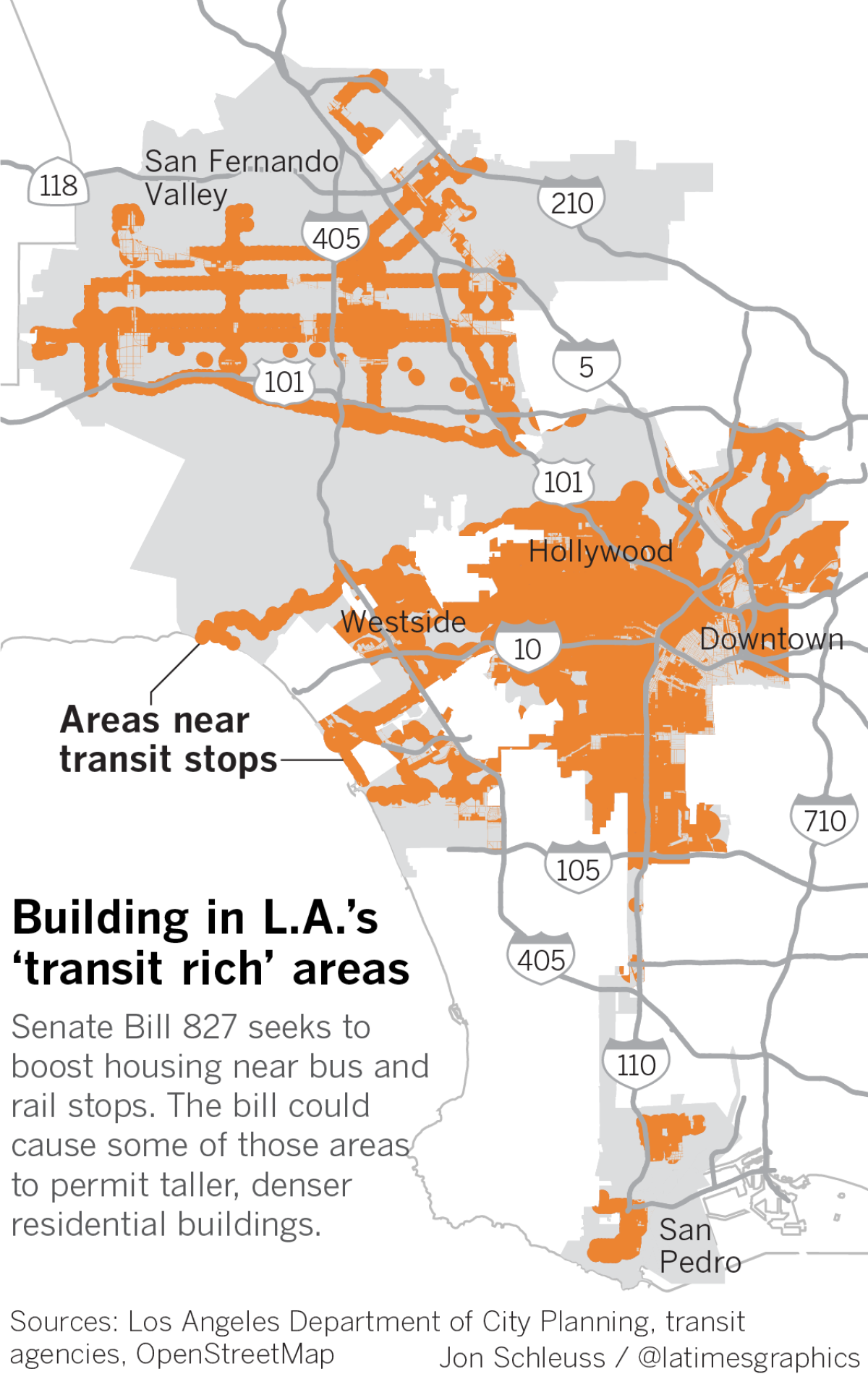
Wiener views his bill as a muscular tool for attacking traffic congestion, climate change and, most importantly, skyrocketing housing costs. With so many Californians struggling to pay their rent, the Legislature can no longer permit city councils and county supervisors to place strict limits on housing construction near major transit stops, he says.
“Public transportation is exactly where you should be putting housing if you’re serious about getting more people onto transit, reducing gridlock, reducing carbon emissions, giving people the option of driving less,” he said.
Foes of the bill say the city already has the planning tools to put more homes near bus and rail. And they warn SB 827 will trigger widespread redevelopment in single-family neighborhoods, low-rise commercial areas and historic preservation districts.
“In the process, you will destroy neighborhoods, destroy the sense of place that many of our neighborhoods and our villages represent,” said former Los Angeles County Supervisor Zev Yaroslavsky, who is now director of the Los Angeles Initiative at the UCLA Luskin School of Public Affairs and the Department of History.
Wiener’s bill would apply to a huge expanse of the L.A. basin because it is crisscrossed with bus routes and, to a much lesser extent, rail lines.
SB 827 would allow residential buildings up to five stories — and on wider streets, up to eight stories — on land within a quarter-mile of a location where buses arrive every 15 minutes during rush hour.
Developments the same size would be allowed within a quarter-mile of subway stations, light rail platforms and places where two major bus corridors intersect. Within a half-mile of such stops, apartments and condominiums could be as tall as four or five stories.
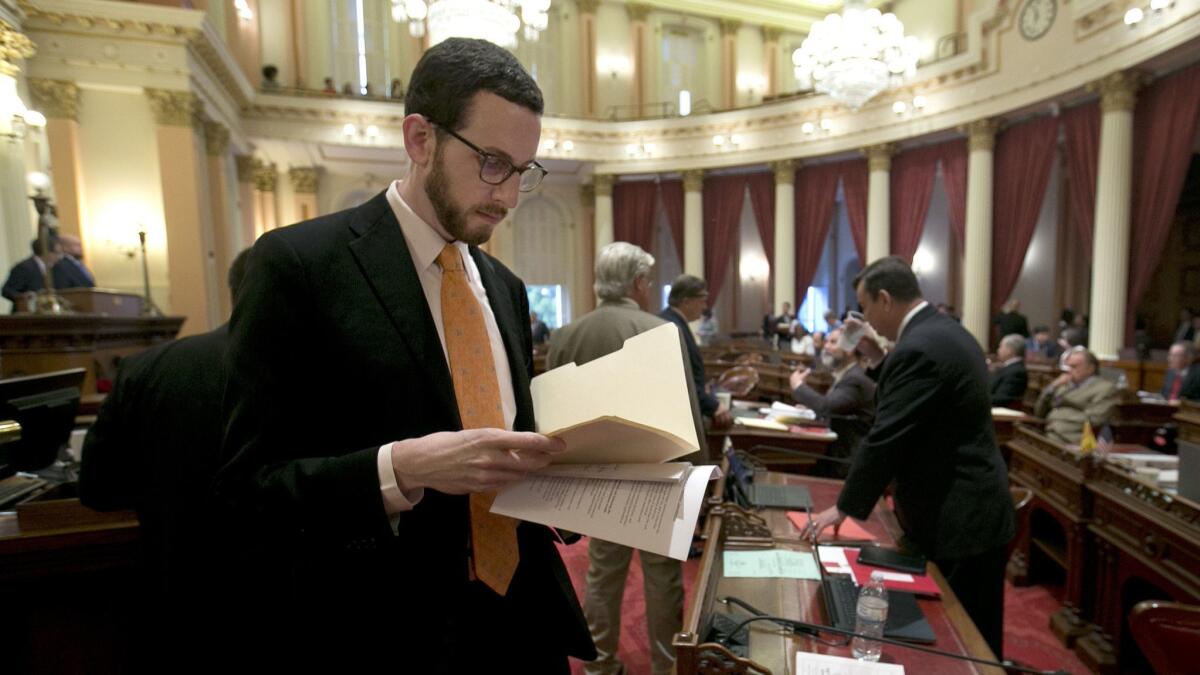
The proposal has been greeted with alarm by an array of L.A. tenant groups, homeowner associations, neighborhood councils and historic preservationists.
Opponents contend the bill will deliver a financial windfall to landlords and homeowners, while placing new burden on low-income renters. With rules allowing taller, denser buildings, property owners would see a significant increase in the value of their holdings — and have a new financial incentive to sell to developers, they argue.
Shashi Hanuman, a directing attorney for Public Counsel, fears those developers will, in turn, demolish rent-controlled buildings and replace them with larger, more expensive ones.
“If you think of a building that’s four to eight units, and it’s upzoned to allow 40 units … the land value will increase and the pressure to tear down that building will increase,” said Hanuman, whose group advocates for low-income families.
Another tenant advocate was more blunt.
“It’ll be gentrification on steroids,” said Larry Gross, executive director of the Coalition for Economic Survival.
Backers of the bill say it has provisions to prevent the displacement of low-income residents. For example, companies that raze a structure using the incentives available under SB 827 would have to pay up to 42 months of rent to each family forced out.
The bill requires that those same families be offered the chance to move back into the replacement building at their prior rent, at least for the first year. And developers would be barred from demolishing rent-controlled buildings unless the City Council passes an ordinance explicitly allowing them to do so — a provision that, so far, has not reassured critics in L.A.
Wiener disputes the idea that his bill would produce a wholesale destruction of older housing stock. Neighborhoods will evolve gradually, as developers acquire building sites and the proper permits, he said.
“This is not some overnight transformation,” he said recently. “It's going to happen over time.”
The Times relied on the city’s most recent bus and rail stop data, information compiled in September, to examine the locations that could be affected by SB 827. Within those areas are more than 86,000 rent-controlled buildings, or about 537,000 total units.
After the bill was introduced, city officials began taking a fresh look at local bus routes to see if they actually run every 15 minutes during rush hour. They say they are still analyzing the areas affected by SB 827.
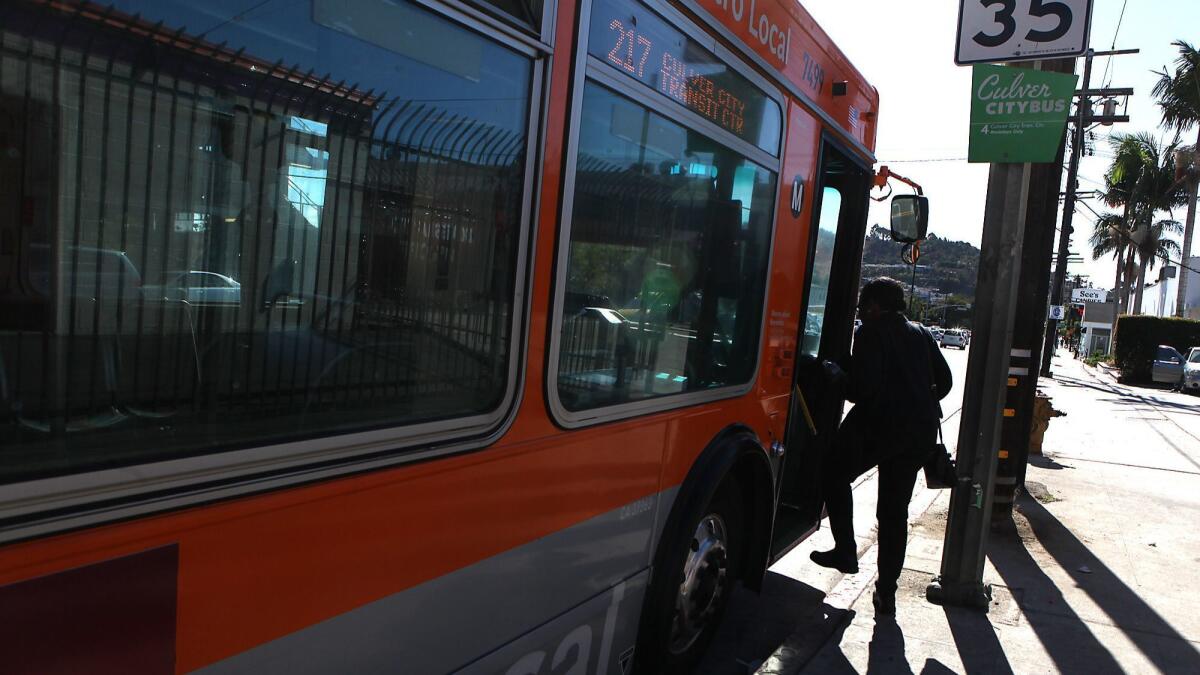
Since it was proposed two months ago, Wiener’s bill has received national attention, drawing praise from academics, urban planners and YIMBYs — pro-housing advocates who have adopted the slogan Yes In My Backyard. The bill went public just as state legislators were trying to tackle multiple housing and environmental challenges at once.
For decades, the state has not built enough new homes to keep pace with demand, forcing prices higher. Public spending to subsidize housing for the state’s poorest residents is annually billions of dollars short of the need. And to meet California’s ambitious climate change goals, state regulators have determined new growth needs to be concentrated near existing jobs and transit rather than urban sprawl.
Wiener’s bill forcefully tackles both the housing shortage and environmental concerns, said Marlon Boarnet, chair of the Department of Urban Planning and Spatial Analysis at USC’s Price School of Public Policy. “This is a bold vision,” he said.
Wiener’s legislation will almost certainly see further changes. Yet even if it is defeated, it will have shifted the conversation around housing in the state legislature, said Lisa Ann Schweitzer, an urban planning professor at USC’s Price School of Public Policy.
Until recently, the authority that cities and counties had over local development was unquestioned. With the state’s housing shortage more acute, policymakers are questioning that dynamic, she said.
“I think the writing is pretty much on the wall ... that local governments are not going to upzone voluntarily unless something radical changes,” Schweitzer said. “I think a lot of people are hoping that the state is the lever that unlocks the gridlock around zoning.”
Backers of SB 827 say the need for change can be found on each side of Wilshire Boulevard west of Koreatown, where construction crews are at work on a $3.2-billion extension of the Metro Purple Line subway. Several neighborhoods along the route, such as Hancock Park and Beverly Grove, have restrictive zoning — a fact that confounds local business leaders.
Jessica Duboff, vice president of public policy for the Los Angeles Area Chamber of Commerce, said residential streets near three planned Purple Line stations — La Brea Avenue, Fairfax Avenue and La Cienega Boulevard — should be rezoned to allow taller apartments and condominiums.
“Those are employment corridors. Those are tourism corridors. And those places are where a big chunk of our transit dollars are going,” she said.
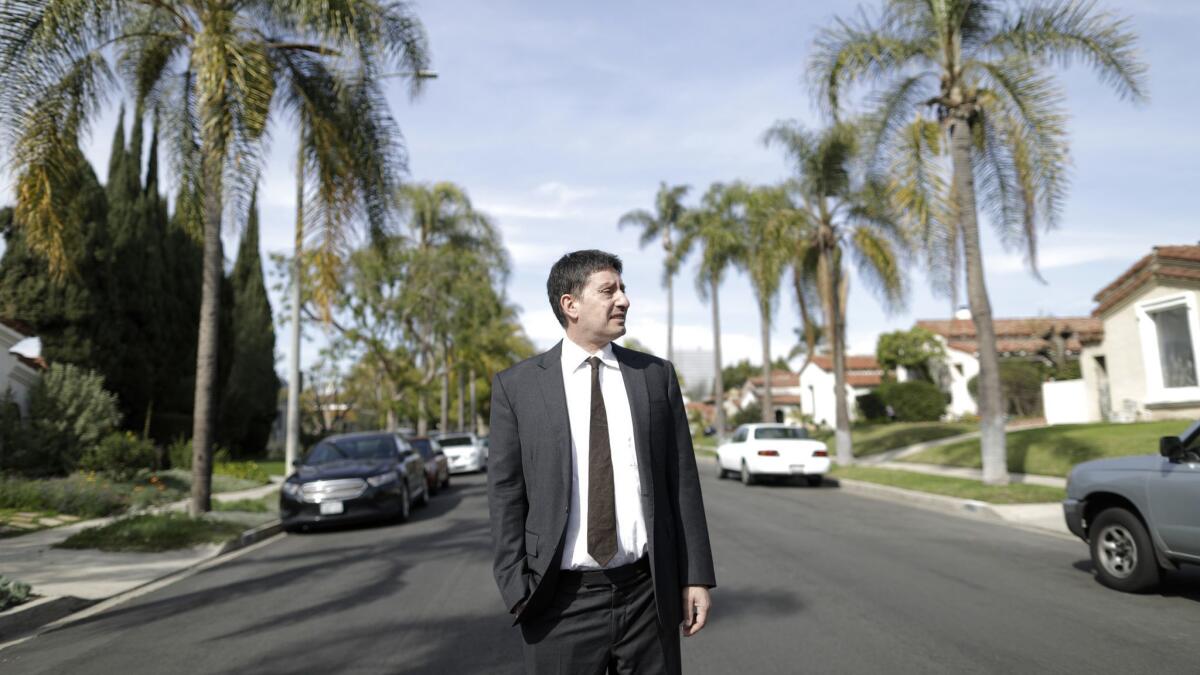
Attorney Brad Kane moved to the South Carthay section of Los Angeles in 1999, lured in part by the Spanish Colonial Revival architecture — rows of houses and duplexes with smooth plaster and red-tile roofs. “It was a beautiful island,” he said. “It was beautiful and it was centrally located and it was protected, or so I thought, from major development.”
Kane is now president of the People Involved in Community Organizing, or Pico Neighborhood Council, which has come out against SB 827. The council serves South Carthay and 10 other neighborhoods — an area bordered by major bus routes. As a result, it is almost entirely covered by SB 827.
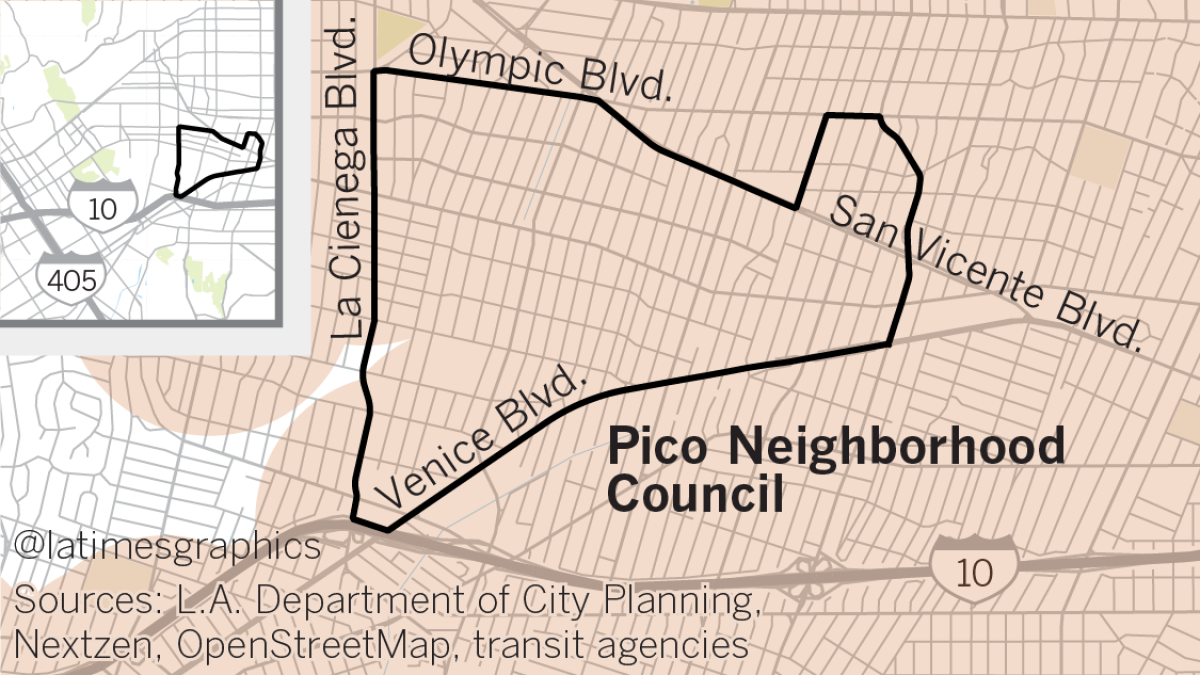
Wiener contends his bill would defer to local rules that protect historic structures from demolition. But Kane is not convinced, and fears that developers will use the city’s rules on renovations as a workaround to raze and replace those homes.
Council President Herb Wesson is backing a resolution to oppose SB 827, which comes up for vote Tuesday. Meanwhile, Mayor Eric Garcetti wants to make sure the bill has renter protections, affordability requirements and “better respects existing neighborhood character,” said Ben Winter, the mayor’s top housing aide.
"As currently written, SB 827 would effectively rezone most of the L.A. Basin — from the Hollywood Hills to the 105 — and large swaths of the Valley,” Winter said in a statement.
SB 827 would have similarly large effects in other big cities across California. Almost all of San Francisco would be rezoned to allow for more housing, according to a report prepared by the city’s planning department.
San Francisco is also considering a resolution to oppose SB 827, with candidates in the city’s June mayoral election divided on the measure.
By contrast, the bill has major backing from San Jose Mayor Sam Liccardo, who said his city is working to increase density around public transit.
Liccardo complained that neighboring communities in Silicon Valley haven’t done enough to increase the supply of housing. He said he’d give up some of his power over zoning issues in his own city if it meant San Jose’s suburbs would have to permit more home building.
Upzoning neighborhoods, he said, “requires having local government with a backbone.”
[email protected] | Twitter: @DavidZahniser
[email protected] | Twitter: @dillonliam
[email protected] | Twitter: @gaufre
Sign up for Essential California
The most important California stories and recommendations in your inbox every morning.
You may occasionally receive promotional content from the Los Angeles Times.










